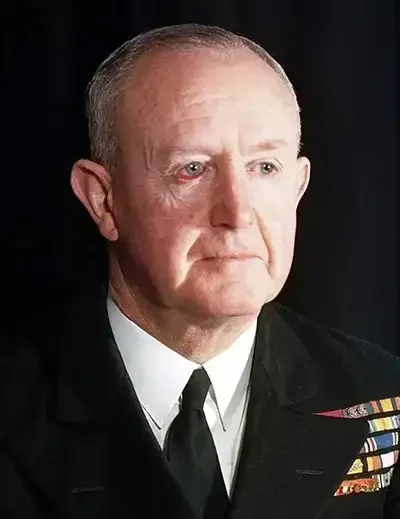- Military History
- Biographies
- Militarians Biographies
- Admiral of the Fleet Sir Andrew Browne Cunningham
Admiral of the Fleet Sir Andrew Browne Cunningham
Great British naval commander in two world wars
Cunningham joined the Royal Navy in 1898 and saw a wide variety of service prior to World War I when he was skipper of the destroyer Scorpion during the Dardanelles campaign (February 19 to November 23 of 1915). He showed great skill and initiative in the raid on the German U-boat base at Zeebrugge on April 23, 1918.
Cunningham remained in the navy between the wars and was appointed by King George V as his Aide-de-camp during 1932-33. In 1934, he was promoted to rear admiral and given command of the destroyer flotilla attached to the Royal Navy's Mediterranean Fleet. He served in this capacity until 1936, when he was named commander of the battle cruiser squadron and made overall second-in-command of the Mediterranean Fleet. He left this post in September 1938 to become deputy naval chief of staff, serving until the outbreak of World War II in June 1939 when he once again was dispatched to the Mediterranean, this time as commander of the fleet.
After the fall of France, Cunningham acted quickly against the French Mediterranean naval force, effectively immobilizing the French fleet at Alexandria by June 1940. Cunningham also triumphed in the first major Mediterranean battle of World War II, overrunning Admiral Angelo Iachino off Calabria on July 9, 1940, severely damaging an Italian battleship and cruiser without suffering serious casualties himself.
Cunningham launched a daring nighttime torpedo bomber strike from his fleet's single aircraft carrier, the H.M.S. Illustrious, which devastated the Italian navy. The November 11, 1940 attack on the Taranto naval base sank and/or badly damaged three battleships, two cruisers and a pair of auxiliary vessels. On March the 28th of 1941 when Admiral Angelo Iachino dispatched a fleet raid, Cunningham intercepted it off Cape Matapan, sinking three cruisers and two destroyers. Because of these two actions, the Italian navy was neutralized for the balance of the war.
Cunningham's fleet covered the evacuations of Greece (April 26-30) and Crete (May 21 to June 1) sustaining severe losses from unremitting German air attacks. Cunningham was also responsible for the survival of Malta by supplying the isolated British outpost by sea throughout June 1941 - June 1942 again despite continual German air assaults.
Cunningham was posted to Washington, D. C. during June - October 1942 to serve as chief British Admiralty representative to the Combined Chiefs of Staff. After receiving promotion to fleet admiral, he returned to the Mediterranean as Allied naval commander-in-chief and on November the 8th in 1942 provided naval cover for the North African Operation Torch landings. Beginning on July 9, 1943 and through August 27, he provided naval support for Operation Husky (the invasion of Sicily).
On September 8, 1943, Cunningham received the surrender of the Italian fleet, then was recalled to London as first sea lord following the resignation of Admiral Sir Dudley Pound. Cunningham served in this office throughout the war until 1946, when he was created First Viscount Cunningham of Hyndhope. In 1951, he published his memoirs “A Sailor's Odyssey” and lived the rest of his life in London, recognized as one of England's greatest sailors and a key presence in the Mediterranean during World War II.
Cunningham died in London on the 12th of June in 1963 and was buried at sea off Portsmouth. There were no children from his marriage and his titles consequently became extinct by his death. Prince Philip, Duke of Edinburgh, unveiled a bust of Cunningham by Franta Belsky in Trafalgar Square in London, April 1967. The April 2010 UK naval operation to ship British military personnel and air passengers stranded in continental Europe by the air travel disruption after the 2010 Eyjafjallajökull eruption back to the UK was named Operation Cunningham after him.
Admiral of the Fleet Sir Andrew Browne Cunningham - Quick Facts
- Battlecruiser Squadron (Royal Navy)
- First Sea Lord and Chief of the Naval Staff (Royal Navy)
- HMS Rodney - 29 (Royal Navy)
- HMS Scorpion (Royal Navy)
- Mediterranean Fleet (Royal Navy)
- Second Boer War (11 October 1899 – 31 May 1902)
- WWI (1914-1918)
- WWII (1939-1945)
- {{#owner}}
- {{#url}} {{#avatarSrc}}
{{name}} {{/url}} {{^url}} {{#avatar}} {{& avatar}} {{/avatar}} {{name}} {{/url}} - {{/owner}} {{#created}}
- {{created}} {{/created}}
























